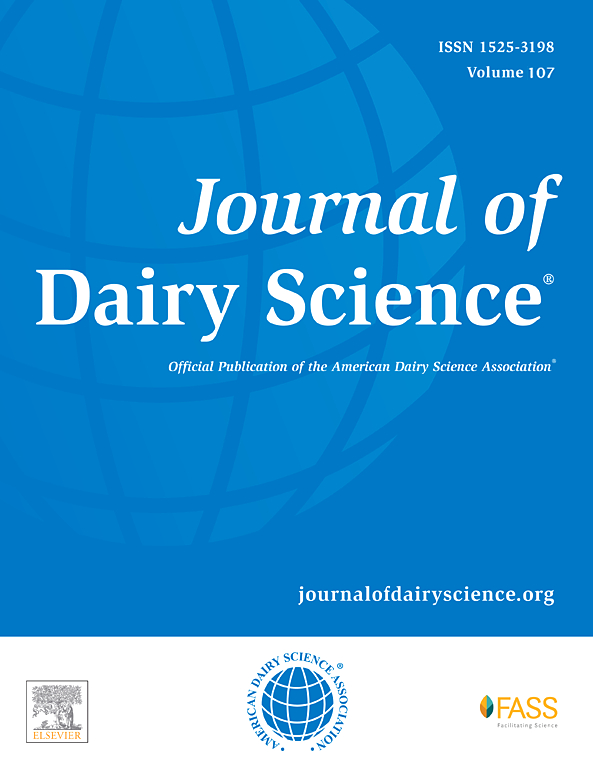Effect of pH adjustments on a novel micellar casein–based edible 3-dimensional printing formulation
IF 4.4
1区 农林科学
Q1 AGRICULTURE, DAIRY & ANIMAL SCIENCE
引用次数: 0
Abstract
Three-dimensional (3D) food printing holds the potential to help reduce food waste by precise portion control and use of materials that are produced in excess or are otherwise discarded. This relatively new technology is likely to undergo decreases in equipment costs. To take advantage of such prospects, we developed a novel micellar casein–based edible 3D printing formulation. Our formulation relies on a highly concentrated micellar casein solution (27.75%, wt/wt, final) along with pH adjustments (3.5, 4.0, 4.8, 6.7, 7.2, and 8.2) at chilled temperature (4–9°C) to avoid premature aggregation. In comparison to the natural pH of 6.7, both alkalinization and acidification past the isoelectric point of 4.6 enhanced both elastic and viscous moduli that enable for shape retention during and after extrusion from a 3D food printer. However, alkalinization led to smaller increases in the viscous modulus and did not lead to the shape retention that acidification to 4.0 or 3.5 does. Both acidification and alkalinization also resulted in rougher surface textures compared with the formulation at pH 6.7. Whereas the pH 4.8 formulation had inferior shape retention qualities compared with those at the other pH values tested, it had optimized water resilience, defined here as minimized swelling and dissolution of dried structures placed in water. Overall, we present a novel casein-based 3D printing formulation that could be printed while chilled, and with properties that could be modified by pH adjustments.
pH值调整对新型胶束酪蛋白可食用3D打印配方的影响。
三维(3D)食品打印有可能通过精确的分量控制和使用生产过剩或被丢弃的材料来帮助减少食物浪费。这项相对较新的技术可能会降低设备成本。为了利用这种前景,我们开发了一种新型的基于胶束酪蛋白的可食用3D打印配方。我们的配方依赖于高度浓缩的胶束酪蛋白溶液(27.75%,wt/wt,最终)以及在冷却温度(4-9°C)下的pH值调整(3.5,4.0,4.8,6.7,7.2和8.2),以避免过早聚集。与自然pH值6.7相比,碱化和酸化超过4.6的等电点都增强了弹性和粘性模量,从而能够在3D食品打印机挤出过程中和挤出后保持形状。然而,碱化导致粘性模量的增加较小,并且不会像酸化到4.0或3.5那样导致形状保持。与pH值6.7的配方相比,酸化和碱化也导致了更粗糙的表面纹理。虽然pH值为4.8的配方与其他pH值的配方相比,形状保持质量较差,但它具有最佳的水弹性,这里定义为将干燥结构放置在水中的溶胀和溶解最小化。总的来说,我们提出了一种新的基于酪蛋白的3D打印配方,可以在冷却的情况下打印,并且可以通过pH值调整来改变其性能。
本文章由计算机程序翻译,如有差异,请以英文原文为准。
求助全文
约1分钟内获得全文
求助全文
来源期刊

Journal of Dairy Science
农林科学-奶制品与动物科学
CiteScore
7.90
自引率
17.10%
发文量
784
审稿时长
4.2 months
期刊介绍:
The official journal of the American Dairy Science Association®, Journal of Dairy Science® (JDS) is the leading peer-reviewed general dairy research journal in the world. JDS readers represent education, industry, and government agencies in more than 70 countries with interests in biochemistry, breeding, economics, engineering, environment, food science, genetics, microbiology, nutrition, pathology, physiology, processing, public health, quality assurance, and sanitation.
 求助内容:
求助内容: 应助结果提醒方式:
应助结果提醒方式:


